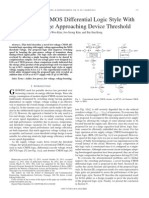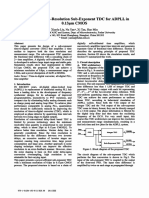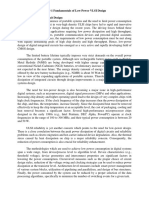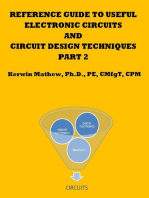Minimization of Redundant Internal Voltage Swing in Cmos Full-Adder
Minimization of Redundant Internal Voltage Swing in Cmos Full-Adder
Uploaded by
Anonymous JnvCyu85Copyright:
Available Formats
Minimization of Redundant Internal Voltage Swing in Cmos Full-Adder
Minimization of Redundant Internal Voltage Swing in Cmos Full-Adder
Uploaded by
Anonymous JnvCyu85Original Description:
Original Title
Copyright
Available Formats
Share this document
Did you find this document useful?
Is this content inappropriate?
Copyright:
Available Formats
Minimization of Redundant Internal Voltage Swing in Cmos Full-Adder
Minimization of Redundant Internal Voltage Swing in Cmos Full-Adder
Uploaded by
Anonymous JnvCyu85Copyright:
Available Formats
MINIMIZATION OF REDUNDANT INTERNAL VOLTAGE SWING IN
CMOS FULL-ADDER
Citharthan Durairaj, Vasanth Rajendran
1VLSI, Electronics and Communication Engineering, Kapagam University, Tamil Nadu, India,
sidharth.durairaj@gmail.com
2VLSI, Electronics and Communication Engineering, Kapagam University, Tamil Nadu, India,
vasanthrajendran1@gmail.com
Abstract
We proposed a CMOS full-adder cell for low-power applications. The proposed logic structure of CMOS full-adder is used to
minimize unnecessary internal voltage swing taken place in the prior CMOS full-adder by adding four nMOS transistors to the
logic structure of SUM circuit and three nMOS transistors to the logic structure of CARRY circuit. These nMOS transistors are
used to minimize the internal voltage swing from (0VDD) to ((0 - Vtp)VDD) during redundant internal voltage transitions. For
area constrain applications, we can use these extra nMOS transistors either to the SUM or CARRY circuit depending upon our
need. The proposed full-adder has maximum of 36ps longer data to output delay as compared to the prior CMOS full-adder. The
full adder was designed with a 0.18 m CMOS technology.
Index Terms: Delay, dynamic power, full-adder, voltage swing.
----------------------------------------------------------------------***-----------------------------------------------------------------1. INTRODUCTION
Addition is a fundamental arithmetic operation that is broadly
used in many VLSI systems, such as application-specific
digital signal processing (DSP) architectures and
microprocessors. This module is the core of many arithmetic
operations such as addition/subtraction, multiplication,
division and address generation. Thus a full-adder having lowpower consumption and low propagation delay results of great
interest for the implementation of modern digital systems.
The average power dissipation in digital CMOS circuits
depends on 1) dynamic power, 2) short-circuit power, 3)
leakage power and 4) static power. The dynamic power
dissipation is the dominant factor compared with the other
components of power dissipation in digital CMOS circuits. As
technology scales down, i.e. for submicron technologies, the
contribution of dynamic power dissipation also increases
because of increased functionality requirements and clock
frequencies [1]. The dynamic power P = CV2f equation
consists of three terms: voltage, capacitance and frequency.
Frequency reduction is the best applied to signals with larger
capacitance. One effective method of reducing switching
frequency is to eliminate logic transitions that are not
necessary for computation [2].
In this paper, the inputs to the nMOS transistors are blocked
during redundant internal logic transitions taken place in
existing CMOS full-adder structure by adding extra nMOS
transistors serially and thereby reducing the redundant internal
voltage swing.
2. LOGIC STRUCTURE OF EXISTING FULLADDER
The logic scheme is shown in Fig.1 [4]. The true-table for a 1bit full-adder is given in Table 1. Examining the true-table and
by referring the logic scheme, it can be seen that for producing
the SUM output, MUX 1 select the output of
value
when C = 0 whereas it select the output of
value when
C = 1. Similarly for producing the CARRY output, MUX 2
select the output of A B value when C = 0 whereas it select
the output of A + B value when C = 1.
The features and advantages of this logic structure listed in [5]
are as follows.
There are not signals generated internally that control
the selection of the output multiplexers. Instead the C
input signal, exhibiting a full voltage swing and no
extra delay, is used to drive the multiplexers,
reducing so the overall propagation delays.
The capacitive load for the C input has been reduced,
as it is connected only to some transistor gates and no
longer to some drain or source terminals, where the
diffusion capacitance is becoming very large for submicrometer technologies. Thus the overall delay for
larger modules where the C signal falls on the critical
path can be reduced.
The propagation delay for the SUM and CARRY
outputs can be tuned up individually by adjusting the
XOR/XNOR and the AND/OR gates; this features is
advantageous for applications where the skew
between arriving signals is critical for a proper
operation, and for having well balanced propagation
delays at the outputs to reduce the chance of glitches
in cascaded applications.
The inclusion of buffers at the full-adder outputs can
be implemented by interchanging the XOR/XNOR
signals, and the AND/OR gates to NAND/NOR gates
at the input of the multiplexers, improving in this
way the performance for load-sensitive applications.
TABLE I
TRUE-TABLE FOR A 1-BIT FULL-ADDER: A, B, AND
C ARE INPUTS; SUM AND CARRY ARE OUTPUTS
In addition to the advantages, the important drawback we have
found about the logic structure is explained below:
3. MODIFIED LOGIC STRUCTURE TO
REDUCE
REDUNDANT
INTERNAL
VOLTAGE SWING
According to the logic scheme of CMOS full-adder, MUX 1
select the
value when C = 0 whereas it select the
value when C = 1. But the logic structure of XOR
continuously produces the output to net 1 (denoted in Fig.1)
even when the input C = 1. Similarly logic structure XNOR
produces the output to net 2 (denoted in Fig. 1) even when the
input C = 0. It causes redundant logic transitions on net 1 and
net 2. The logic structure of XOR/XNOR in the full-adder was
implemented using double
pass-transistor logic style (DPL) and swing restored
complementary pass transistor logic style (SR-CPL) [5].
However both logic styles suffer from redundant internal
voltage transitions. Since net 1 and net 2 have higher
capacitances (approximately half the oxide capacitances of
pass transistors in XOR and XNOR logic, wire capacitances,
and half the oxide capacitances of transmission gates) it causes
higher power dissipation. It also follows for net 3 and net 4
(denoted in Fig.1) due to continuous operations done by AND
and OR circuit. So we need to avoid this unwanted internal
logic transitions without much degradation in performance.
The modified DPL logic of XOR and XNOR to produce the
SUM output is shown in Fig.2. Here we added four nMOS
transistors to the existing XOR and XNOR logic structure.
The gate control of added nMOS transistors in XOR logic
structure is
whereas in XNOR logic structure is input C. So
that inputs to the nMOS transistors are blocked in XOR logic
when the input C = 1 and in XNOR logic when the input C =
0. Thus switching transitions are taken place from (0 Vtp)VDD instead of 0VDD during redundant operations
(XOR output when C = 1 and XNOR output when C = 0).
This minimizes the redundant voltage swing in net 1 and net 2.
However this will increase the load for input C due to the
increased gate voltages. But due to the smaller size of
transistors the capacitive load will be smaller compared to the
net 1 and net 2. In addition, the input transition
Fig-1: Existing logic scheme for designing full-adder cells.
Fig-2: DPL logic of modified XOR and XNOR to produce the
SUM output.
Fig-4: a) Input voltage C b) existing XOR logic output to net
1 c) modified XOR logic output to net 1 d) existing XNOR
logic output to net 2 e) modified XNOR logic output to net 2.
Pdynamic
(2)
Fig-3: Modified AND and OR circuit to produce the CARRY
output.
probability of input C is lesser when compared to the input
transition probability of A and B. Similar actions are taken for
net 3 and net 4. Three nMOS transistors are added to the
existing AND and OR logic structure such that inputs to the
nMOS transistors are blocked in AND logic when the input C
= 1 and in OR logic when the input C = 0. The modified pass
transistor logic structure to produce the CARRY output is
shown in Fig.3.
We control the inputs of nMOS transistors to avoid extra delay
and to minimize area. However if we control the inputs of
pMOS transistors the peak voltage on the nets will be reduced
to (VDD-Vtn) during redundant operations.
CL.VDD2.N
(0VDD).f
In the above equation N (0VDD) is the number of rising
transitions at the output or equivalently the number of times
CL is charged to VDD. Fig.4 shows the existing and modified
output voltages of net 1 and net 2 with respect to the input
voltage C. Fig.5 shows the existing and modified output
voltages of net3 and net4 with respect to the input voltage C.
The inputs C, B and A are as per the true-table (i.e. 000111).
VDD for the operation is 1.8 V. For redundant operations (XOR
and AND logic output on net 1 and net 3 when C = 1, XNOR
and OR logic output on net 2 and net 4 when C = 0) in the
modified logic structure the equation (2) is modified as
Pdynamic
(3)
CL.VDD2.N
((0
Vtp)VDD).f
The capacitances on the net 1, net 2, net 3 and net 4 are
charged to VDD from (0 - Vtp) instead of 0 during redundant
operations. This reduces the voltage swing which can be
clearly seen from Fig.4 and Fig.5.
4. PERFORMANCE COMPARISONS
4.1Dynamic Power
The average power dissipation of the circuit is expressed as
Paverage = Pdynamic + Pshort-circuit + Pleakage + Pstatic
(1)
Pdynamic is the dynamic power dissipation due to switching of
transistors. Pdynamic is caused by the charging and discharging of
capacitances in the circuit.
Fig.-5: a) Input voltage C b) existing AND logic output to net
3 c) modified AND logic output to net 3 d) existing OR logic
output to net 4 e) modified OR logic output to net 4.
The proposed full-adder can operate properly with voltage
supply as low as 0.6 V. Since these realization have neither
static consumption, nor internal direct paths from V DD to Gnd
(except for the inverters at the inputs, which could be avoided
if the inputs come from Flip-Flops with complementary
outputs), they are good candidates for battery-operated
applications where low consumption modules with standby
modes are required. The transistors in the proposed full-adder
are minimal and not larger than 1
m (except for the
symmetrical response inverters at the input).
4.2. Delay
Due to the extra nMOS transistors the proposed logic structure
of full-adder introduces a falling delay compared to the
existing logic structure of full-adder. The maximum output
delay associated with proposed full adder structure compared
to the existing is only 36ps.
CONCLUSION
A modified logic structure to reduce redundant internal
voltage swing in CMOS full-adder cell was proposed. The
proposed logic is used to minimize the voltage swing from
(0VDD) to ((0 - Vtp)VDD) during redundant internal logic
transitions. The outputs are simulated using Cadence virtuoso.
The simulations showed that the proposed logic structure of
full-adder is well suitable to low-power applications, and the
power supply voltage can be lowered down to 0.6 V,
maintaining proper functionality.
REFERENCES
[1] Dimitrious Soudris, Christian Piguet, and Costas Goutis,
Designing CMOS Circuits for Low Power, Kluwer
academic publishers, pp. 10-12
[2] Gary Yeap, Practical Low Power Digital VLSI Design,
Kluwer academic publishers, pp. 1-3
[3] A. M. Shams and M. Bayoumi, Performance evaluation of
1-bit CMOS adder cells, in Proc. IEEE ISCAS, Orlando, FL,
May 1999, vol. 1, pp.27-30.
[4] M. Aguirre and M. Linare, An alternative logic approach
to implement high speed low power full adder cells,. in Proc.
SBCCI, Florianopolis, Brazil, Sep.2005, pp. 166-171.
[5] Mariano Aguirre-Hernandez and Monico Linares-Aranda,
CMOS
full-adders for
energy-efficient
arithmetic
applications, IEEE Trans. Very Large Scale Integr (VLSI)
Syst. vol. 19, no.4, pp.718-721, Apr. 2011.
[6] R.Zimmerman and W. Fichtner, Low power logic
styles:CMOS versus pass-transistor logic, IEEE J.Solid-State
Circuits, vol.32, no.7, pp. 1079-1090, Jul. 1997.
[7] A.M. Shams, T.K. Darwish, and M.Bayoumi,
Performance analysis of low-power 1-bit CMOS full adder
cells, in Proc.SBCCI, Florianopolis, Brazil, Sep.2005, pp.
166-171.
BIOGRAPHIES:
D. Citharthan was born in Kumbakonam,
6th Sep 1987. He was completed B.E
Electrical and Electronics Engineering in
Panimalar Engineering College, Chennai,
Tamil Nadu, India.
He is pursuing Master degree in VLSI in
Karpagam University, Coimbatore, Tamil
Nadu, India. His research area includes
CMOS Design and Low power VLSI.
R.Vasanth was born in Dharapuram, 20th
Nov
1986.
He
was
completed
M.Sc.,M.Phil in Applied Electronics in
RVS College of Arts and Science, Sulur,
Coimbatore, Tamil Nadu, India.
He is pursuing Master degree in VLSI in
Karpagam University, Coimbatore, Tamil
Nadu, India. His research area includes
Low power VLSI and Industrial
Electronics.
You might also like
- Tri State InverterDocument18 pagesTri State InverterManasa Upadhyaya100% (1)
- Nand 2 Nor 2Document19 pagesNand 2 Nor 2Nagendra BoyellaNo ratings yet
- Double Tail ComparatorDocument32 pagesDouble Tail ComparatormdlogicsolutionsNo ratings yet
- Static Cmos DesignDocument7 pagesStatic Cmos Designtechspaceofatul100% (5)
- A Novel High Speed and Energy Efficient 10 Transistor Full Adder DesignDocument20 pagesA Novel High Speed and Energy Efficient 10 Transistor Full Adder Designneethusebastian1989No ratings yet
- Vlsi DesignDocument31 pagesVlsi Designajas777BNo ratings yet
- Speed and Energy Full Adder Design Restoring Logic: A High Using Complementary & Level CarryDocument4 pagesSpeed and Energy Full Adder Design Restoring Logic: A High Using Complementary & Level CarryBappy DebnathNo ratings yet
- Design of Low PowerDocument13 pagesDesign of Low PowerSachin AgrawalNo ratings yet
- A 1.8Ghz Cmos: Low-Power Truly-Modular Programmable Divider in Standard TechnologyDocument4 pagesA 1.8Ghz Cmos: Low-Power Truly-Modular Programmable Divider in Standard TechnologyMuhammad_Swilam_2010No ratings yet
- Single Bit Full Adder Design Using 8 Transistors With Novel 3 Transistors XNOR GateDocument13 pagesSingle Bit Full Adder Design Using 8 Transistors With Novel 3 Transistors XNOR GateAnonymous e4UpOQEPNo ratings yet
- A Comparative Performance Analysis of Various CMOS Design Techniques For XOR and XNOR CircuitsDocument10 pagesA Comparative Performance Analysis of Various CMOS Design Techniques For XOR and XNOR CircuitsGarima PantNo ratings yet
- Low Power Full AdderDocument6 pagesLow Power Full Adderdurairajmary100% (1)
- Design and Optimization of ÷8/9 Divider in PLL Frequency Synthesizer With Dynamic Logic (E - TSPC)Document5 pagesDesign and Optimization of ÷8/9 Divider in PLL Frequency Synthesizer With Dynamic Logic (E - TSPC)himaja1No ratings yet
- CMOS Full Adder Circuit TopologiesDocument9 pagesCMOS Full Adder Circuit TopologiesAamodh KuthethurNo ratings yet
- Regular Correspondence: Compact High-Frequency Output Buffer For Testing of Analog CMOS VLSI CircuitsDocument3 pagesRegular Correspondence: Compact High-Frequency Output Buffer For Testing of Analog CMOS VLSI CircuitsSaranya ChakrabortyNo ratings yet
- VLSI Design Module 2 _Circuit Characterization and Performance Estimation_ notes (1)Document13 pagesVLSI Design Module 2 _Circuit Characterization and Performance Estimation_ notes (1)rashmiNo ratings yet
- Treesa s2Document5 pagesTreesa s2jayalakshmisnairNo ratings yet
- A Broadband Cmos Multiplier-Based Correlator For Ir-Uwb Transceiver SocDocument4 pagesA Broadband Cmos Multiplier-Based Correlator For Ir-Uwb Transceiver SocmiracuNo ratings yet
- Design of An ADC Using High Precision Comparator With Time Domain Offset CancellationDocument4 pagesDesign of An ADC Using High Precision Comparator With Time Domain Offset CancellationijtetjournalNo ratings yet
- VLSI Design SoC CH 6Document125 pagesVLSI Design SoC CH 6Arqam Ali KhanNo ratings yet
- A New Design 6T Full Adder Circuit Using Novel 2T XNOR GatesDocument7 pagesA New Design 6T Full Adder Circuit Using Novel 2T XNOR GatesdycsteiznNo ratings yet
- Study and Analysis of High Performance Xnor Based 1-Bit Full Adder CellDocument5 pagesStudy and Analysis of High Performance Xnor Based 1-Bit Full Adder CellInternational Journal of Application or Innovation in Engineering & ManagementNo ratings yet
- Digital CMOS Logic Operation in The Sub-Threshold Region: Hendrawan Soeleman and Kaushik RoyDocument6 pagesDigital CMOS Logic Operation in The Sub-Threshold Region: Hendrawan Soeleman and Kaushik Royphanindra21No ratings yet
- A 6-b 1-GS/s 30-mW ADC in 90-nm CMOS Technology: Yuan-Ching Lien and Jri Lee National Taiwan University, Taipei, TaiwanDocument4 pagesA 6-b 1-GS/s 30-mW ADC in 90-nm CMOS Technology: Yuan-Ching Lien and Jri Lee National Taiwan University, Taipei, TaiwanSunil PandeyNo ratings yet
- KKKDocument13 pagesKKKVineet KushwahNo ratings yet
- A Novel Low Power, High Speed 14 Transistor CMOS Full Adder Cell With 50% Improvement in Threshold Loss ProblemDocument5 pagesA Novel Low Power, High Speed 14 Transistor CMOS Full Adder Cell With 50% Improvement in Threshold Loss Problemsorat2007No ratings yet
- 2011 Scaling CPLDocument5 pages2011 Scaling CPLankushwreNo ratings yet
- Lab2 PabillaranDocument9 pagesLab2 PabillaranLouise Lope PabillaranNo ratings yet
- A Low Power A - D Converter 05613669Document4 pagesA Low Power A - D Converter 05613669Romualdo Begale PrudêncioNo ratings yet
- Low Swing Signaling Using A Dynamic Diode-Connected DriverDocument4 pagesLow Swing Signaling Using A Dynamic Diode-Connected DriverAkash RaykarNo ratings yet
- Research Article: 9T Full Adder Design in Subthreshold RegionDocument5 pagesResearch Article: 9T Full Adder Design in Subthreshold Regiondeepa_sinha_3No ratings yet
- Final ProjectDocument5 pagesFinal Projectnksharma.naveen1855No ratings yet
- Ambipolar Electronics: Xy3, mr11, Kmram @rice - EduDocument5 pagesAmbipolar Electronics: Xy3, mr11, Kmram @rice - EduKrishna PrasadNo ratings yet
- A O.8ps Minimum-Resolution Sub-Exponent TDC For ADPLL in O.13Jlm CMOSDocument4 pagesA O.8ps Minimum-Resolution Sub-Exponent TDC For ADPLL in O.13Jlm CMOSApikShafieeNo ratings yet
- Coupling-Driven Signal Encoding Scheme For Low-Power Interface DesignDocument4 pagesCoupling-Driven Signal Encoding Scheme For Low-Power Interface DesignshastryNo ratings yet
- Fundamentals of Adiabatic Logic: 2.1 The Charging Process in Adiabatic Logic Compared To Static CMOSDocument19 pagesFundamentals of Adiabatic Logic: 2.1 The Charging Process in Adiabatic Logic Compared To Static CMOSparsa_coaNo ratings yet
- Jecet: Journal of Electronics and Communication Engineering & Technology (JECET)Document9 pagesJecet: Journal of Electronics and Communication Engineering & Technology (JECET)IAEME PublicationNo ratings yet
- A Low Power Single Phase Clock Distribution Using VLSI TechnologyDocument5 pagesA Low Power Single Phase Clock Distribution Using VLSI TechnologyNano Scientific Research Centre pvt ltd100% (1)
- Basic Design of SCLDocument4 pagesBasic Design of SCLDunna SrinivasraoNo ratings yet
- A Comparative Study of CMOS LNAsDocument4 pagesA Comparative Study of CMOS LNAsMohammad Arif SaberNo ratings yet
- Electronic System Design PPT - Electrical Behavior of CMOS and BiCMOSDocument6 pagesElectronic System Design PPT - Electrical Behavior of CMOS and BiCMOSAnoop MathewNo ratings yet
- Analysis of Energy Efficient PTL Based Full Adders Using Different Nanometer TechnologiesDocument6 pagesAnalysis of Energy Efficient PTL Based Full Adders Using Different Nanometer TechnologiesDwarakaManeekantaAddagiriNo ratings yet
- UNIT-1 Fundamentals of Low Power VLSI Design Need For Low Power Circuit DesignDocument15 pagesUNIT-1 Fundamentals of Low Power VLSI Design Need For Low Power Circuit DesignPVenkataPuneethhNo ratings yet
- Lvlsid Mid-i NotesDocument53 pagesLvlsid Mid-i Notessaranlovely433No ratings yet
- D 119Document35 pagesD 119Mohammad Ayatullah MaktoomNo ratings yet
- An-791 A Simplified Approach To VHF Power Amplifier DesignDocument10 pagesAn-791 A Simplified Approach To VHF Power Amplifier DesignEdward YanezNo ratings yet
- Cmos Transistor AdderDocument9 pagesCmos Transistor AdderRahul KannojiaNo ratings yet
- Domino Logic CircuitsDocument4 pagesDomino Logic CircuitsSahil BansalNo ratings yet
- Extending The SPI Bus For Long Distnce CommDocument7 pagesExtending The SPI Bus For Long Distnce CommFelipe Ademir Aleman Hdez100% (2)
- Low Power CMOS Digital Circuit Design Methodologies With Reduced Voltage SwingDocument4 pagesLow Power CMOS Digital Circuit Design Methodologies With Reduced Voltage SwingMaheshNo ratings yet
- DeDocument7 pagesDeSudhakar SpartanNo ratings yet
- Tty To Rs232Document8 pagesTty To Rs232sandeepverma8257100% (2)
- 05682957Document4 pages05682957Praveenkumar ViswanathanNo ratings yet
- Minimization Leakage Current of Full Adder Using Deep Sub-Micron CMOS TechniqueDocument7 pagesMinimization Leakage Current of Full Adder Using Deep Sub-Micron CMOS TechniqueInternational Journal of Application or Innovation in Engineering & ManagementNo ratings yet
- Maximum Leakage Power Estimation For CMOS CircuitsDocument9 pagesMaximum Leakage Power Estimation For CMOS Circuitsowais74No ratings yet
- IJECE-V3I6P103Document4 pagesIJECE-V3I6P10321x51a0437No ratings yet
- Reference Guide To Useful Electronic Circuits And Circuit Design Techniques - Part 2From EverandReference Guide To Useful Electronic Circuits And Circuit Design Techniques - Part 2No ratings yet
- High-Performance D/A-Converters: Application to Digital TransceiversFrom EverandHigh-Performance D/A-Converters: Application to Digital TransceiversNo ratings yet
- Analog Dialogue, Volume 48, Number 1: Analog Dialogue, #13From EverandAnalog Dialogue, Volume 48, Number 1: Analog Dialogue, #13Rating: 4 out of 5 stars4/5 (1)
- Marginalized Group PDFDocument5 pagesMarginalized Group PDFAnonymous JnvCyu85No ratings yet
- IBDP Book ListDocument1 pageIBDP Book ListAnonymous JnvCyu85No ratings yet
- Types of Socializing Agent PDFDocument7 pagesTypes of Socializing Agent PDFAnonymous JnvCyu85No ratings yet
- Dimensions of Growth and Development PDFDocument7 pagesDimensions of Growth and Development PDFAnonymous JnvCyu85No ratings yet
- Dimensions of Development PDFDocument7 pagesDimensions of Development PDFAnonymous JnvCyu85No ratings yet
- Factors Affecting Environment Pollution PDFDocument3 pagesFactors Affecting Environment Pollution PDFAnonymous JnvCyu85No ratings yet
- Marginalized Children PDFDocument4 pagesMarginalized Children PDFAnonymous JnvCyu85No ratings yet
- Factors Influencing Growth and Development PDFDocument6 pagesFactors Influencing Growth and Development PDFAnonymous JnvCyu85No ratings yet
- Impact of Media Violence PDFDocument4 pagesImpact of Media Violence PDFAnonymous JnvCyu85No ratings yet
- Characteristics of Growth and Development PDFDocument9 pagesCharacteristics of Growth and Development PDFAnonymous JnvCyu85No ratings yet
- EC6001 Medical ElectronicsDocument15 pagesEC6001 Medical ElectronicsAnonymous JnvCyu85No ratings yet
- Accenture Question Paper 1Document10 pagesAccenture Question Paper 1Anonymous JnvCyu85No ratings yet
- Using The SDRAM PDFDocument14 pagesUsing The SDRAM PDFemmanuelNo ratings yet
- Ahmed Mohamed Ahmed Morsy DR / Hazem Hassan ENG / Sherry HeshmatDocument31 pagesAhmed Mohamed Ahmed Morsy DR / Hazem Hassan ENG / Sherry Heshmatahmed morsyNo ratings yet
- Lecture On TTLDocument16 pagesLecture On TTLAkhil M PNo ratings yet
- MadeEasy ESE Conventional Paper For Digital ElectronicsDocument3 pagesMadeEasy ESE Conventional Paper For Digital ElectronicsPrafulla AnuragNo ratings yet
- Chapter Sixteen: Metal Oxide Semiconductor Field Effect Transistors (Mosfet)Document13 pagesChapter Sixteen: Metal Oxide Semiconductor Field Effect Transistors (Mosfet)SOURABH SHARMANo ratings yet
- NAND Flash: Code Information (1/3)Document3 pagesNAND Flash: Code Information (1/3)hoang_tuanNo ratings yet
- Digital Electronics RevisionDocument23 pagesDigital Electronics Revisionapi-3701035100% (2)
- Unit 2 ActivityDocument19 pagesUnit 2 ActivityRiza Pahama Mananaong100% (1)
- CMOS Hex Buffers/Converter Features: Top ViewDocument8 pagesCMOS Hex Buffers/Converter Features: Top ViewGenesis RosarioNo ratings yet
- ASIC Design Flow - SynopsysDocument18 pagesASIC Design Flow - SynopsysDavid CheNo ratings yet
- Ecs 915gv-M5a Rev 1.0BDocument36 pagesEcs 915gv-M5a Rev 1.0Buir100% (1)
- Module - 4: 8051 Timers and Serial PortDocument37 pagesModule - 4: 8051 Timers and Serial PortPramod Patil100% (1)
- Half/Full Adder AndHalf/Full SubtractorDocument6 pagesHalf/Full Adder AndHalf/Full SubtractorJames Kevin Ignacio100% (10)
- Digital Electronics and Microprocessor Lecture NotesDocument187 pagesDigital Electronics and Microprocessor Lecture Notes514 Vaibhavi PawarNo ratings yet
- ATmega128 Application NotesDocument386 pagesATmega128 Application NotesArun P MadhavNo ratings yet
- What Is Instruction Queue in 8086 MicroprocessorDocument2 pagesWhat Is Instruction Queue in 8086 MicroprocessorAnouar Dhahri50% (2)
- 2023 Ch4-Elmore DelayDocument38 pages2023 Ch4-Elmore DelayAn NguyenNo ratings yet
- Peavey Cross Reference PDFDocument24 pagesPeavey Cross Reference PDFangel miguel rodriguez moralesNo ratings yet
- Nhập môn An toàn Thông tinDocument26 pagesNhập môn An toàn Thông tinDuc Anh Vu TranNo ratings yet
- Low Power PDFDocument42 pagesLow Power PDFMayur AgarwalNo ratings yet
- Student's ManualDocument69 pagesStudent's ManualMichael CagaoanNo ratings yet
- Wood Textures v1 CatalogVPDocument53 pagesWood Textures v1 CatalogVPMatias LeboNo ratings yet
- Eee f348 Fpga Based Sys Desg Lab p1Document2 pagesEee f348 Fpga Based Sys Desg Lab p1f20230220No ratings yet
- DELD Unit I & Unit II MCQDocument39 pagesDELD Unit I & Unit II MCQGauri TupeNo ratings yet
- Experiment No.: 01 Experiment Name: Study of Logic Gates and Verification of Their Truth TablesDocument3 pagesExperiment No.: 01 Experiment Name: Study of Logic Gates and Verification of Their Truth TablesPiyas ChowdhuryNo ratings yet
- USBASP - Help3Document19 pagesUSBASP - Help3Julio Antonio Negrin OlivosNo ratings yet
- SR Flip Flop JK Flip FlopDocument7 pagesSR Flip Flop JK Flip FlopIshu MiglaniNo ratings yet
- Overview for Mosfet And IGBT Gate Drivers Mosfet 和 Igbt 栅极驱动器电路的基本原理Document5 pagesOverview for Mosfet And IGBT Gate Drivers Mosfet 和 Igbt 栅极驱动器电路的基本原理kheralahNo ratings yet
- Architecture (MODULE I)Document18 pagesArchitecture (MODULE I)Arka Prava PaulNo ratings yet
- The Berkeley Out - of - Order Machine (Boom!) : An Open - Source Industry - Compeeeve, Synthesizable, Parameterized Risc - V ProcessorDocument45 pagesThe Berkeley Out - of - Order Machine (Boom!) : An Open - Source Industry - Compeeeve, Synthesizable, Parameterized Risc - V Processorkbkkr100% (1)





































































































